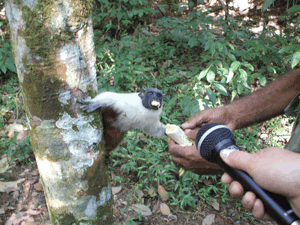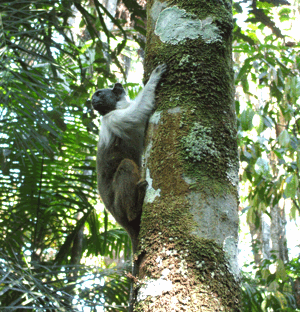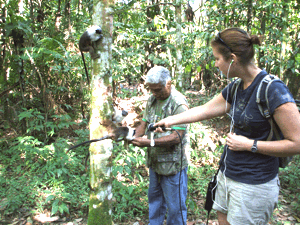Urban Jungle Monkey
Air Date: Week of February 19, 2010

A Brazil Nut Saki enjoys a hand-fed mid-morning snack. (Photo: Marco Lima)
Manaus, Brazil is a city of two million people completely surrounded by the Amazon rainforest. Living on Earth’s Bobby Bascomb reports on a species of monkey found nowhere else in the world who are making themselves at home in the urban jungle.
Transcript
YOUNG: In the middle of the Amazon basin, the world’s largest rainforest, is the city of Manaus. And in the middle of the city of two million people live 112 very unusual residents, found no where else in the world. Living on Earth’s Bobby Bascomb reports.
[MANAUS CITY SOUNDS]
BASCOMB: Mindu is a slice of rainforest in the middle of a city. It’s the largest park in Manaus with 75 acres of thick vines and lush forest.
[MONKEY SOUNDS]
LIMA: You know this guy here, this is the most impressive one we have inside of a Brazilian town.
BASCOMB: Marco Lima is a Brazilian biologist. He watches a park naturalist feed finger-sized bananas to a group of white, brown and black monkeys.
[MONKEY EATING SOUND]

A Brazil Nut Saki enjoys a hand-fed mid-morning snack. (Photo: Marco Lima)
LIMA: That is the Brazil nut saki. It used to be called the saki from Manaus because it’s only found in Manaus.
[KISSING SOUND]
BASCOMB: There are about 130 different types of monkey in the Amazon. One third of those were discovered in the last 20 years. But Lima says the Brazil nut saki is unique.
LIMA: They are a small monkey with a very little tiny face, size of a small hand. But what do they have that’s really incredible is the size of their tail. They don’t use it to move around but they use it to make their jumps stable. This is something very different comparing them to all the other monkeys in the Amazon.

The Brazil Nut Saki is locally known as the Monkey from Manaus. (Photo: Bobby Bascomb)
BASCOMB: And unlike other monkeys in the jungle the sakis are urban dwellers. In the past two decades Manaus has grown dramatically. The monkeys managed to survive in relatively tiny pockets of forest as the city expanded around them. 112 of the endangered sakis now live in the city and Lima says there’s no going back to the jungle.
LIMA: In the Amazon we have many rivers. All the big rivers, they are natural biological walls. They isolate species. Many species cannot simply swim and say, oh let’s go to the other side of the river. Let’s buy a boat and cross the other side of the river. They don’t do that. So this isolates them.
[MONKEY SOUNDS]
LIMA: These places are nature pit stops for many species. Manaus is in a very strategic point because if you just cross the Amazon River from Manaus, pristine rainforest. Manaus it is a town of about 200 square miles and outside of it, beautiful nature. We need to remember that we are the second comers.

Living on Earth’s Bobby Bascomb records feeding time at Mindu Park. (Photo: Marco Lima)
BASCOMB: But the first residents of the forest, the football-sized Brazil nut sakis are thriving in their home in the urban jungle.
[MONKEY SOUNDS]
BASCOMB: Is that one with a baby up there? On that tree?
LIMA: Uh…yeah, it has a baby. (Portuguese) Yeah, it has a baby. Look at here - this is already a success of a place like this just to see life keep on going, you know.
[KISSING SOUNDS]
BASCOMB: For Living on Earth, I’m Bobby Bascomb in Manaus, Brazil.
[KISSING SOUNDS]
Living on Earth wants to hear from you!
Living on Earth
62 Calef Highway, Suite 212
Lee, NH 03861
Telephone: 617-287-4121
E-mail: comments@loe.org
Newsletter [Click here]
Donate to Living on Earth!
Living on Earth is an independent media program and relies entirely on contributions from listeners and institutions supporting public service. Please donate now to preserve an independent environmental voice.
NewsletterLiving on Earth offers a weekly delivery of the show's rundown to your mailbox. Sign up for our newsletter today!
 Sailors For The Sea: Be the change you want to sea.
Sailors For The Sea: Be the change you want to sea.
 The Grantham Foundation for the Protection of the Environment: Committed to protecting and improving the health of the global environment.
The Grantham Foundation for the Protection of the Environment: Committed to protecting and improving the health of the global environment.
 Contribute to Living on Earth and receive, as our gift to you, an archival print of one of Mark Seth Lender's extraordinary wildlife photographs. Follow the link to see Mark's current collection of photographs.
Contribute to Living on Earth and receive, as our gift to you, an archival print of one of Mark Seth Lender's extraordinary wildlife photographs. Follow the link to see Mark's current collection of photographs.
 Buy a signed copy of Mark Seth Lender's book Smeagull the Seagull & support Living on Earth
Buy a signed copy of Mark Seth Lender's book Smeagull the Seagull & support Living on Earth

